
| |
|
Kumquat |
Serving Size
1 medium fruit, raw (19g)
|
Amount Per Serving |
% Daily Value |
| Calories 15 |
|
| Calories
from Fat 0 |
|
| Total Fat
0g |
0% |
|
Saturated Fat 0g |
0% |
|
Cholesterol 0mg |
0% |
| Sodium
0mg |
0% |
| Total
Carbohydrate 3g |
1% |
| Dietary
Fiber 1g |
4% |
| Sugars
2g |
|
| Protein 0g |
|
| Vitamin
A |
2% |
| Vitamin C |
15% |
| Calcium |
2% |
| Iron |
0% |
* Percent Daily Values are based on a
2,000 calorie diet.
|
|
| |
|
Kumquats can appear in markets from October (at the earliest) through
June, and during some unpredictable off-season times as well. Considered a
winter fruit, their golden color is a welcome sight. Select fruits that
are firm, not soft. Because of their skin, they tend to spoil more easily
than thicker skinned fruits such as oranges. Kumquats will last a few days
at room temperature or for up to two weeks in the refrigerator. The entire
kumquat is consumed in a bite or two. Because of their size and color, they
are also great as drink garnishes or as an addition to salads. Wash
kumquats before serving.
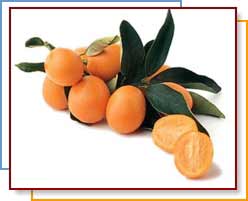
| |
|
Sapote |
Serving Size:
1 med. fruit (225g)
|
Amount Per Serving |
% Daily Value |
| Calories 300 |
|
| Calories
from Fat 10 |
|
| Total Fat
1.5g |
1% |
|
Saturated Fat 0g |
0% |
|
Cholesterol 0mg |
0% |
| Sodium
20mg |
0% |
| Total
Carbohydrate 76g |
25% |
| Dietary
Fiber 6g |
24% |
| Sugars
0g |
|
| Protein 5g |
|
| Vitamin
A |
20% |
| Vitamin C |
70% |
| Calcium |
8% |
| Iron |
10% |
* Percent Daily Values are based on a
2,000 calorie diet.
|
|
| |
|
Sapote is quite rare in the United States. Only a few acres in Florida and
California are planted with this fruit. Sapote has a orange flesh that is
unusually soft, juicy, creamy and has a sweet, mild flavor that hints at
flavors such as coconut, vanilla, and lemon. Sapotes are the size of a
grapefruit or orange and are bright green or brown in color. This fruit is
a native of the highlands of Mexico, but has grown in California since the
early 1800s. Varieties such as the mamey, black skinned, green skinned,
yellow skinned and about half a dozen more uncommon varieties pop up in
grocery stores and farmer’s markets from time to time.
Sapotes are generally on the market in fall and winter, but seasonality
can vary from year to year. Select hard fruits and store at room
temperature. However, they last only about 3 days. Chill briefly before
serving. This fruit can be frozen as well; wrap the whole fruit and tuck
into the freezer. To serve, half thaw in the refrigerator, and then scoop
the rest out like sherbet.
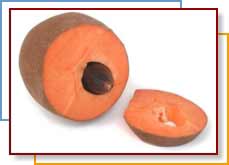
| |
|
Pepino Melon |
Serving Size:
1 medium (100g)
|
Amount Per Serving |
% Daily Value |
| Calories 80 |
|
| Calories from Fat
0 |
|
|
Total Fat 0g |
0% |
|
Saturated Fat --g |
--% |
|
Cholesterol --mg |
--% |
| Sodium
0mg |
0% |
| Total
Carbohydrate 22g |
7% |
| Dietary
Fiber 5g |
18% |
| Sugars
--g |
|
| Protein 0g |
|
| Vitamin
A |
--% |
| Vitamin C |
--% |
| Calcium |
--% |
| Iron |
--% |
* Percent Daily Values are based on a
2,000 calorie diet.
|
|
| |
|
Pepino melon is native to Peru, but is now also grown in California and
New Zealand. It is also known as treemelon, bush melon and mellowfruit.
Pepino’s are teardrop shaped and have a smooth skin that is striped with
yellow and dark purple. The flesh of this fruit is fragrant and combines
the tastes of cantaloupe and honeydew.
Pepinos are available late fall to mid-spring. Fruits with a light yellow
or green skin are not ripe, while fruits with dark purple stripes are
ripe. Ripen at room temperature until as firm as a slightly ripe plum,
then refrigerate ripe fruit for up to 3 days.
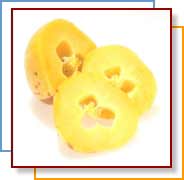
| |
|
Cherimoyas |
Serving Size:
½ cup (78g)
|
Amount Per Serving |
% Daily Value |
| Calories
57.5 |
|
| Calories from
Fat 7.5 |
|
|
Total Fat 0.5g |
1% |
|
Saturated Fat --g |
--% |
|
Cholesterol 0mg |
0% |
|
Sodium 3mg |
0% |
|
Total Carbohydrate 14g |
5% |
|
Dietary Fiber 2g |
7% |
| Sugars
1.2g |
|
| Protein 5g |
|
|
Vitamin A |
0% |
|
Vitamin C |
15% |
|
Calcium |
0% |
|
Iron |
1% |
* Percent Daily Values are based on a
2,000 calorie diet.
|
|
| |
|
This fruit is also known as the custard apple or sherbet fruit, and
there are more than 50 varieties. It is large and pinecone like in
appearance with a green exterior. Cherimoyas are juicy with a creamy white
flesh and large, black seeds and tastes like a combination of pineapple,
mango, papaya and vanilla.
Cherimoyas are available November through May. Choose fruits that are
yellow-green, firm and without blemishes. Dark spots and splotches should
be avoided. Cherimoyas will ripen at room temperature for a few days until
softened. They can then be tightly wrapped and refrigerated for up to 4
days.
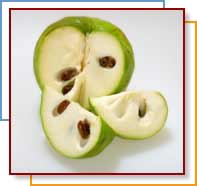
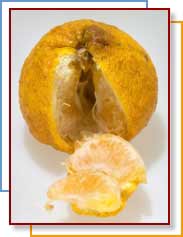 Ugli fruits are named after their appearance which is generally
discolored, pot-marked and odd-shaped. However, it gets a bad rap; it
really has a very sweet, citrus taste, is peeled easily and is seedless,
making it a great snack or addition to salads. The outside is a
greenish-yellow color and has a shape that is between an orange and a
pear. Ugli fruits are native to Jamaica and have been propagated in the
United States
since the 1930s. They are said to combine the best qualities of
tangerines, grapefruit and Seville oranges. Children love the taste and
their intriguing name. Ugli fruits are named after their appearance which is generally
discolored, pot-marked and odd-shaped. However, it gets a bad rap; it
really has a very sweet, citrus taste, is peeled easily and is seedless,
making it a great snack or addition to salads. The outside is a
greenish-yellow color and has a shape that is between an orange and a
pear. Ugli fruits are native to Jamaica and have been propagated in the
United States
since the 1930s. They are said to combine the best qualities of
tangerines, grapefruit and Seville oranges. Children love the taste and
their intriguing name.
Choose fruits that are heavy and have no sign of drying at the ends.
The fruit should give with slight pressure much like grapefruit. Color is
not important when choosing, and pot-marks and small dents are normal.
Uglis can be kept at room temperature for about 5 days, or in the
refrigerator for up to 2 weeks. Uglis should not be cooked or it will lose
flavor.
Recipes
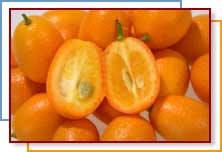
Exotic Fruit Salad
Makes 6 servings
Each serving equals 1 1/2 cups fruit or vegetables
Ingredients
1 head romaine lettuce
1 head Belgian endive
1 cup fresh mint leaves
2 large oranges
2 ugli fruit
½ cup pineapple juice
3 Tbsp freshly squeezed lemon juice
3 Tbsp sugar
1/8 tsp salt
½ tsp ground cinnamon
3 Tbsp walnut oil
½ cup golden raisins
1/3 cup walnuts or macadamia nuts, chopped and toasted
1/3 cup slivered almonds, toasted
Wash and dry lettuce, endive, and mint; set aside in a large bowl. Peel
oranges and ugli fruit, removing all the pith. Divide into segments and
place in a bowl. In a small bowl, combine the pineapple juice, lemon
juice, sugar, salt, cinnamon, and walnut oil. Mix well; set aside. Toss
the chilled greens with the dressing to taste. Place greens on a large
platter and top with orange and ugli fruit segments, raisins, and nuts.
Nutritional analysis per serving: Calories 282, Protein 5g, Fat 14g,
Calories From Fat 44%, Cholesterol 0mg, Carbohydrates 37g, Fiber 7g, Sodium
83mg.
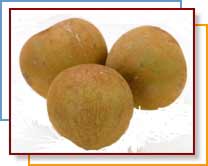
Find more in our
recipe database!
|



